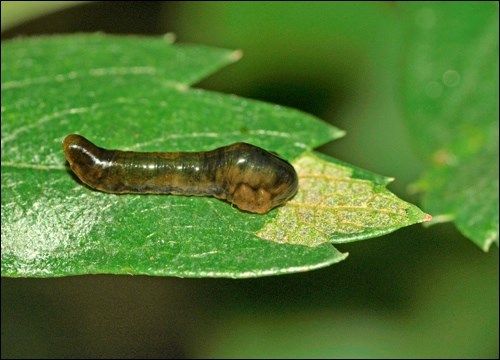If you own a cotoneaster hedge, you know what pear slugs are. They are relatively small (five to 12 millimetres long) and initially slimy, green-black slug-like creatures that, in bad years, can cover your hedge, gradually skeletonizing the leaves. I say slug-like since they are actually the immature (larval) form of Caliroa cerasi, a small sawfly, related to ants, bees and wasps rather than to common garden slugs, snails and their ilk. They attack other plants in addition to cotoneaster: pear (of course), plum, mountain ash, saskatoon berry, cherry, pin cherry, hawthorn and chokecherry.
For effective control, I always say, know your enemy. This particular enemy over winters in a cocoon five to eight centimetres below the soil surface near the base of host plants. Adults emerge in June and early July. After a brief love affair, females insert their eggs under the leaf surface. Larvae hatch after one to two weeks and then begin stripping the leaf surface between the veins.
During their early immature stages (instars), larvae appear slimy, dark grey-green, lack distinct legs and have an obvious larger head then the rest of their body. In the final larval stage, they resemble small, yellow-orange caterpillars now with distinct legs (which true slugs will never have). Larvae complete their developmental phase after two to three weeks and then drop to the ground where they pupate in below-ground earthen cells. In favourable years (that is for pear slugs), a second adult generation may emerge in August to start the cycle again. This second generation is naturally larger than the first and hence more damaging.
Initially, damage may appear as leaf discolouration, mottling or small yellow spots. As feeding continues, affected areas expand, forming distinct white or reddish-brown patches. Because of their contrasting colour, the larvae are quite noticeable.
Management should be focused on the relatively slow-moving larvae since trying to control the short-lived, faster adults (slightly larger than a housefly) is not practical. Start looking for insect damage in late June/early July. Continue monitoring for the rest of the summer. Control is most effective when the infestation is small and in the early stages.
With small infestations, hand pick affected leaves (complete with pear slugs) and drop them into soapy water. In the fall, remove all leaves and lightly rake the soil around plants to expose cocoons (try not to cause too much root damage). With heavier infestations and when leaves are out of easy reach on taller shrubs and trees, products containing carbaryl (e.g. Sevin) and insecticidal soap are registered for pear slug control. Before spraying, make sure you still have something to control. Mature larva may have already exited the scene to over winter underground leaving behind just the damaged leaves. Always read pesticide labels carefully for correct application, timing and safety precautions. If spraying on fruit bearing trees and shrubs, pay particular attention to pre-harvest interval (minimum number of days to wait between spraying and harvest).
— This column is provided courtesy of the Saskatchewan Perennial Society (www.saskperennial.ca; [email protected]; www.facebook.com/saskperennial). Check out our Bulletin Board or Calendar for upcoming garden information sessions, workshops, tours and other events: August 6, Country Garden Tour (306-242-2320; [email protected]; www.saskatoonhortsociety.ca); Aug. 7, Nest (nestsaskatoon.net) Secret Garden Tour (passports available at Dutch Growers, McNally Robinson, Anthology). GardenLine is here for the season to help solve your gardening glitches. Free. Phone 306-966-5865 or email [email protected].




